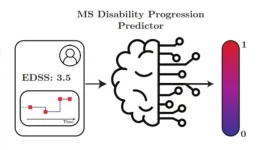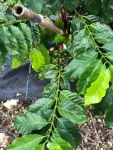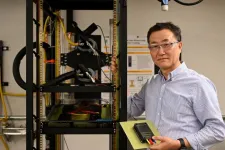(Press-News.org) In this Special Issue of Science, four Reviews and a Policy Forum explore the intersections of science, health, and policy related to the air we breathe, tackling topics including how air pollution is monitored, what impacts it has on human health, how those impacts are felt most by populations with fewer resources, and what changes we can make to the built environment to secure clean air.
In one Review, Wei Huang and colleagues discuss the new air quality guidelines from the World Health Organization (WHO) and related challenges in improving air quality and health. Wealthy countries have robust air pollution data, they note, while Low- and Middle-Income Countries (LMICs) lack infrastructure for such monitoring. Advances in satellite technology and air pollution modeling can help bridge these data gaps, but economic disparities persist, hindering LMICs from mitigating air pollution risks effectively. Huang et al. stress the urgency of implementing air pollution intervention policies with measurable indicators and developing evidence-based risk communication strategies for timely protection of vulnerable populations. A second Review, by Joshua Apte and Chirag Manchanda, explores high-resolution urban air pollution mapping. Two of the most popular mapping methods, mobile monitoring and low-cost sensor networks, have complementary strengths in measuring urban air quality, say the authors. Mobile monitoring captures pollutants at fine spatial scales and informs control strategies, while sensor networks provide temporal resolution at multiple locations. In a third Review, Daniel Mork and colleagues examine the impact of government policies on disparities in air pollution exposure in the US. They highlight the burden of air pollution borne by marginalized communities, partly due to a legacy of racist and exclusionary policies. To better analyze these complex relationships, Mork emphasizes the need for data that links policies, environmental exposures, socioeconomic factors, and health outcomes. In a fourth Review, Lidia Morawska and colleagues discuss the importance of ventilation and indoor air quality, drawing lessons from the COVID-19 pandemic. They emphasize the need for clean indoor air to reduce infection risks and improve general well-being. The authors review seven key findings on improving indoor air quality through new monitoring and ventilation approaches. “In addition to negative health consequences and fear, the pandemic has revealed that there are major deficits in terms of clean air supply to indoor spaces,” write the authors. “An improvement in this situation is urgently needed, not only to reduce the risk of infection by airborne pathogens but also for general well-being.”
Lastly, in a Policy Forum, Alastair Lewis and colleagues show that despite increasing evidence and awareness about the harmful impacts of air pollution, many countries continue to have weak air quality policies. Lewis et al. argue that current legal requirements need to evolve to effectively achieve clean air. According to the authors, raising the ambition of air quality policies isn’t just about meeting WHO standards but also fostering a flexible regulatory environment where science, law, and policy can accelerate progress toward global clean air goals.
END
Special Issue, “Clearing the air,” explores air pollution monitoring, health impacts, and more
Summary author: Walter Beckwith
2024-07-25
ELSE PRESS RELEASES FROM THIS DATE:
Human-induced warming has driven increasing precipitation variability
2024-07-25
Anthropogenic climate warming has led to increased precipitation variability over much of the globe, according to a new study, which points to several hotspots for this trend. This effect is particularly prominent over Europe, Australia, and eastern North America, say the study’s authors, and is largely driven by increasing atmospheric moistening and decadal-scale changes in atmospheric circulation. As the climate warms, the atmosphere becomes more capable of holding moisture, leading to greater fluctuations between extreme precipitation events and wider swings between wet and dry episodes. Such amplified ...
Revealed: Neurons that help create infant-mother bonds in young mice
2024-07-25
Specific neurons in the brain’s zona incerta (ZI) play a crucial role in the early social interactions of an infant and its mother, building their bond and reducing stress, according to a new study in mice. Activation of the same neurons in adult mice increased anxiety- and fear-like responses, the study showed. In humans, as in other mammals, infants have an inborn tendency to form an attachment bond with their mothers or caregivers – a bond that plays a crucial role in the infant’s development. This bond helps newborns feel secure and serves as a safety net from which to explore their surroundings, learn, and develop crucial skills and behaviors. However, the neural mechanisms ...
Can a computer tell patients how their multiple sclerosis will progress?
2024-07-25
Machine learning models can reliably inform clinicians about the disability progression of multiple sclerosis, according to a new study published this week in the open-access journal PLOS Digital Health by Edward De Brouwer of KU Leuven, Belgium, and colleagues.
Multiple sclerosis (MS) is a chronic progressive autoimmune disease that leads to severe disability over time through a complex pattern of progression, recovery, and relapse. Its global prevalence has increased by more than 30% over the last decade. ...
Novel human lung organoids can form lifelike models for tuberculosis infection, and might be used to test efficacy of anti-TB drugs
2024-07-25
Novel human lung organoids can form lifelike models for tuberculosis infection, and might be used to test efficacy of anti-TB drugs.
####
Article URL: http://journals.plos.org/plospathogens/article?id=10.1371/journal. ppat.1012295
Article Title: Advances in an In Vitro Tuberculosis Infection Model Using Human Lung Organoids for Host-Directed Therapies
Author Countries: Republic of Korea
Funding: This research was supported by the Korea National Institutes of Health (NIH) (No. 2021-ER2001-00) awarded to E.M.K., the Korea Institute of Toxicology, Republic of Korea (No. 1711195891) awarded to E.M.K., the Korea Environment Industry & Technology ...
Spin qubits go trampolining
2024-07-25
Researchers at QuTech developed somersaulting spin qubits for universal quantum logic. This achievement may enable efficient control of large semiconductor qubit arrays. The research group published their demonstration of hopping spins in Nature Communications and their work on somersaulting spins in Science.
In 1998, Loss and DiVincenzo published the seminal work ‘quantum computation with quantum dots’. In their original work, hopping of spins was proposed as a basis for qubit logic, but an experimental implementation has remained lacking. After more than 20 years, experiments have caught up with theory. Researchers ...
Seven steps to achieving the right to clean indoor air post-pandemic
2024-07-25
Professor Morawska, director of THRIVE, from QUT’s School of School of Earth and Atmospheric Sciences said the rapid global spread of Covid-19 had soon made it clear the world was unprepared to respond appropriately.
“In the early days of the pandemic the World Health Organisation and many national health authorities claimed the virus was ‘not in the air’ but rather present in large quantities on surfaces. This led to a misconception about how the virus was transmitted,” ...
Scientists study how to bring you ‘climate-smart coffee’
2024-07-25
Crave that cup of coffee in the morning? Globally, consumers drink more than 2.2 billion cups daily. Someone grows all that joe: More than 100 million farmers worldwide produce coffee.
Coffee beans consumed across the globe come from two species: Coffea arabica and Coffea canephora, also known as Robusta (or Conilon) coffee. Historically, coffee drinkers prefer Arabica beans for their specific flavor and aroma, said Felipe Ferrao, a University of Florida research assistant scientist in horticultural sciences.
But by 2050, about 80% of Arabica production is predicted to decrease because of climate change. So, Ferrao and colleagues from France (RD2 Vision) and Brazil (Incaper ...
New study shows at-home colon cancer screening test reduces risk of colorectal cancer death, as effective as screening colonoscopy
2024-07-25
COLUMBUS, Ohio – A noninvasive colorectal cancer screening test that can be done at home could reduce the risk of colorectal cancer death by 33%, according to a new study published in JAMA Network Open. This is the first study to evaluate this tool’s effectiveness in specific racial groups.
For this study, researchers at The Ohio State University Comprehensive Cancer Center – Arthur G. James Cancer Hospital and the Richard J. Solove Research Institute (OSUCCC – James), and Kaiser Permanente evaluated data from nearly 11,000 patients who underwent at-home FIT (fecal immunochemical testing) among ...
A cool solution
2024-07-25
Artificial intelligence (AI) is hot right now. Also hot: the data centers that power the technology. And keeping those centers cool requires a tremendous amount of energy.
The problem is only going to grow as high-powered AI-based computers and devices become commonplace. That’s why University of Missouri researcher Chanwoo Park is devising a new type of cooling system that promises to dramatically reduce energy demands.
“Cooling and chip manufacturing go hand-in-hand,” said Park, a professor of mechanical and aerospace engineering in the Mizzou College of Engineering. “Without proper cooling, components overheat and fail. Energy-efficient data centers will be key ...
Electrical currents may make body’s cancer-killing cells even better killers
2024-07-25
Scientists have discovered that electrical currents may make Natural Killer (NK) cells – our very own cancer-killing immune cells – even better killers, which could have significant implications for treating some cancers.
The scientists found that Tumour Treating Fields (TTF) in the laboratory (which mimic exposure of brain tumours to electric currents via a simple hat worn by patients) evoked an even more deadly response from NK cells. They hope their promising findings may open the door to new combined therapies for people living with certain brain tumours, such as glioblastoma.
Glioblastoma is an aggressive, common ...
LAST 30 PRESS RELEASES:
Tracing the quick synthesis of an industrially important catalyst
New software sheds light on cancer’s hidden genetic networks
UT Health San Antonio awarded $3 million in CPRIT grants to bolster cancer research and prevention efforts in South Texas
Third symposium spotlights global challenge of new contaminants in China’s fight against pollution
From straw to soil harmony: International team reveals how biochar supercharges carbon-smart farming
Myeloma: How AI is redrawing the map of cancer care
Manhattan E. Charurat, Ph.D., MHS invested as the Homer and Martha Gudelsky Distinguished Professor in Medicine at the University of Maryland School of Medicine
Insilico Medicine’s Pharma.AI Q4 Winter Launch Recap: Revolutionizing drug discovery with cutting-edge AI innovations, accelerating the path to pharmaceutical superintelligence
Nanoplastics have diet-dependent impacts on digestive system health
Brain neuron death occurs throughout life and increases with age, a natural human protein drug may halt neuron death in Alzheimer’s disease
SPIE and CLP announce the recipients of the 2025 Advanced Photonics Young Innovator Award
Lessons from the Caldor Fire’s Christmas Valley ‘Miracle’
Ant societies rose by trading individual protection for collective power
Research reveals how ancient viral DNA shapes early embryonic development
A molecular gatekeeper that controls protein synthesis
New ‘cloaking device’ concept to shield sensitive tech from magnetic fields
Researchers show impact of mountain building and climate change on alpine biodiversity
Study models the transition from Neanderthals to modern humans in Europe
University of Phoenix College of Doctoral Studies releases white paper on AI-driven skilling to reduce burnout and restore worker autonomy
AIs fail at the game of visual “telephone”
The levers for a sustainable food system
Potential changes in US homelessness by ending federal support for housing first programs
Vulnerability of large language models to prompt injection when providing medical advice
Researchers develop new system for high-energy-density, long-life, multi-electron transfer bromine-based flow batteries
Ending federal support for housing first programs could increase U.S. homelessness by 5% in one year, new JAMA study finds
New research uncovers molecular ‘safety switch’ shielding cancers from immune attack
Bacteria resisting viral infection can still sink carbon to ocean floor
Younger biological age may increase depression risk in older women during COVID-19
Bharat Innovates 2026 National Basecamp Showcases India’s Most Promising Deep-Tech Ventures
Here’s what determines whether your income level rises or falls
[Press-News.org] Special Issue, “Clearing the air,” explores air pollution monitoring, health impacts, and moreSummary author: Walter Beckwith



